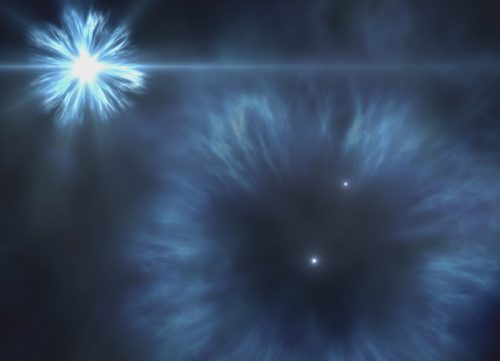Astronomers have located large amounts of oxygen in the atmosphere of one of the oldest stars - a 'primitive star' which they call J0815+4729. These new findings provide an important clue as to how oxygen and other important elements were formed in the first generation of stars in the universe.

[Translation by Dr. Nachmani Moshe]
An international team of astronomers from the University of California at San Diego and the University of Cambridge found large amounts of oxygen in the atmosphere of one of the oldest stars - a 'primitive star' which they call J0815+4729. These new findings, obtained with the help of the Hawaii Observatory and after analyzing the chemical composition of the ancient star, provide an important clue as to how oxygen and other important elements were formed in the first generation of stars in the universe. The findings have long been published in the scientific journal The Astrophysical Journal Letters.
"These results are very exciting. "They provide us with insights into the earliest times of the universe, with the help of the stars in our galaxy's backyard," said lead researcher John O'Meara. "I am excited about the near future where we can get similar results and thus gain better insights into the earliest creation of oxygen and other elements in our young universe."
Oxygen is the most common element in the universe, after hydrogen and helium, and is essential for all life forms on Earth. In addition, it is the chemical basis of the respiratory process and the building block of carbohydrates. Oxygen is also the main element in the composition of the Earth's crust. However, oxygen did not exist in the primordial universe; Oxygen was created through nuclear fusion that occurred deep inside most massive stars, stars with masses at least ten times the mass of our Sun. Understanding the origin of the ancient production of oxygen, and other elements, requires the study of the oldest stars still in existence. The star J0815+4729 is such a star; It is five thousand light years away from Earth, towards the constellation Lynx.
"Stars like this star are defined as hollow stars," explains one of the researchers. "This is in light of their spherical distribution around the Milky Way, this is in contrast to the more familiar flat disk-shaped distribution of younger stars that include our Sun." Hollow stars such as J0815+4729 are truly ancient stars, thus allowing astronomers a glimpse into the earliest production process of elements in our universe.
The collection of the data, which was obtained with the help of a telescope, required observing the star for more than five consecutive hours throughout an entire night, and these were used to measure the concentrations of 16 chemical elements in the atmosphere of the stars, including oxygen. "The basic composition of the star shows that it was formed during the first hundreds of millions of years after the Big Bang, probably from the material scattered from the first supernova in the Milky Way," explains one of the researchers. The data collected with the help of the telescope revealed an unusual chemical composition. While the composition includes relatively large amounts of carbon, nitrogen and oxygen - approximately ten, eight and three percent respectively of the concentration measured in our sun - other elements such as calcium and iron were in concentrations of about one millionth of that in our sun. "Only a few such stars are known in our hollow galaxy, but none of them contain such large amounts of carbon, nitrogen and oxygen, compared to the concentration of iron inside them," one of the researchers adds.
to the notice of the researchers
More of the topic in Hayadan:

8 תגובות
Ilan Shabbat
Plants breathe oxygen and emit PAH just like us - this is their breathing process.
Certain plants, under suitable conditions, carry out photosynthesis, and in this process they do emit oxygen.
The oxygen is not a byproduct of metabolism.
You are right that excess oxygen is toxic, but excess water can also be dangerous (actually - excess of anything).
Oxygen is a toxic substance (poison) created by the respiration process of plants. The poison (oxygen) filled and accumulated in the world and threatened life on earth. Oxygen in high concentration is a substance that destroys living cells.
Fortunately for us, an organism was created that consumed this oxygen and we humans evolved from it in the process of evolution. It is possible that the star that was discovered with the oxygen started a phase of creating life like here on Earth
Yehuda
Materna milk for you
Tham
One way to detect oxygen is to look at the star's light as the planet passes in front of it. Part of the light passes through the atmosphere, and its composition changes according to the light absorbed by the atmosphere.
If you take a prism and pass white light through it, you will get all the colors of the rainbow. But, if you put a gas in the way, then a small part of the light will be absorbed, depending on the type of gas.
the milky way?, maybe the milky way??
a question,
How do you know there is oxygen on a star 5000 light years away?
How do you know the age of the star?
An ancient star 5000 light years away from Earth? Shouldn't it be hundreds of millions of light years away from the Milky Way?
Wow amazing...
My dream is to work at NASA, and my mother is also a mom and dad at home